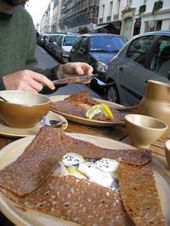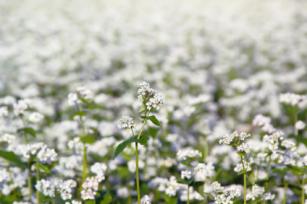
© April McGregerJust add Paris: buckwheat crepes in their glory.
My love for buckwheat first blossomed in the Soba-ya shops of Japan. Years later, that love was rekindled on the sidewalks of Paris eating Galletes de Sarrasin, or Breton-style savory buckwheat crepes, washed down with hard apple cider in stoneware cups. I found the deep, pleasantly bitter, and earthy flavor of buckwheat satisfying and nourishing. The soba noodles were delicate and wholesome; the crepes were lacy yet substantial.
Buckwheat is a curious and misunderstood food. It's not a grain, but is treated like one. It's actually a shrub, related to rhubarb, and its seeds or kernels are what get ground into flour. Buckwheat has been a traditional food around the world, particularly in regions with short growing seasons and poor soil. Eastern Europeans eat a porridge of toasted buckwheat kernels, or groats, known as kasha. In the mountainous region of Lombardy, Italy, a buckwheat pasta, known as pizzoccheri, is a traditional winter fare. They toss it with butter, cabbage, cheese, garlic, and sage.
Buckwheat has a lot going for it: It offers dynamic flavor, contains no gluten, has as much as four times the fiber of whole wheat flour, and is a complete protein. I figured it was time buckwheat got its culinary due stateside.
As often happens when I begin to research "new" ingredients like buckwheat or chestnuts, I often find that the food is not new at all, but a lost or obscure tradition. It turns out that buckwheat was one of the earliest crops introduced to North American by Europeans. Buckwheat griddlecakes and cane syrup or sorghum molasses were considered a most fortifying breakfast for early American pioneers, homesteaders, and farmers.
According to Glenn Roberts, founder of
Anson Mills, "grain" consumption in the United States was once much more diverse. In order to farm successfully without modern chemical fertilizers, crop rotation and cover cropping was necessary. Buckwheat was a key player in good, natural farming practices. It was planted to break up heavy clay soils, to control erosion, and as a valuable green manure. In addition, the nectar from buckwheat flowers is much loved by bees and makes a delicious dark colored honey, and buckwheat flour was a valuable food in its own right, particularly during the cold months.

Buckwheat in the field
Buckwheat cultivation declined sharply in the 20th century due the use of synthetic nitrogen fertilizer. Interestingly - unlike crops like corn and wheat - buckwheat plants yield less in soils treated with synthetic nitrogen.
Buckwheat's history reveals a direct connection between the rise of modern agriculture - with its chemical-intensive monocrops - and the decline of traditional foodways and the emergence of a homogenized Western diet based on refined grains, meat, and sweets. We must then realize the connection between reviving heirloom grains, fixing the broken food system of the United States, and returning to the tradition of natural farming.Buckwheat Crepes, or Galettes de SarrasinSweet crepes are very popular and widespread in the United States, but the savory buckwheat crepe remains obscure. By far my preferred crepe, it is basic and unpretentious - but also totally elegant. Crepes require a bit of practice to master, but once you do, you'll get lots of dinner party mileage out of the simple technique. Fillings are endlessly adaptable and are any easy way to turn leftovers into satisfying, nourishing comfort food. Traditionally, buckwheat crepes are made with just water, but the milk makes them slightly easier to deal with. If you are new to crepe making, I recommend sticking to easy low-prep fillings until you get your timing down.
Comment: For more information about Buckwheat and a crepe recipe read the thread on the Forum Buckwheat - A Super Food!